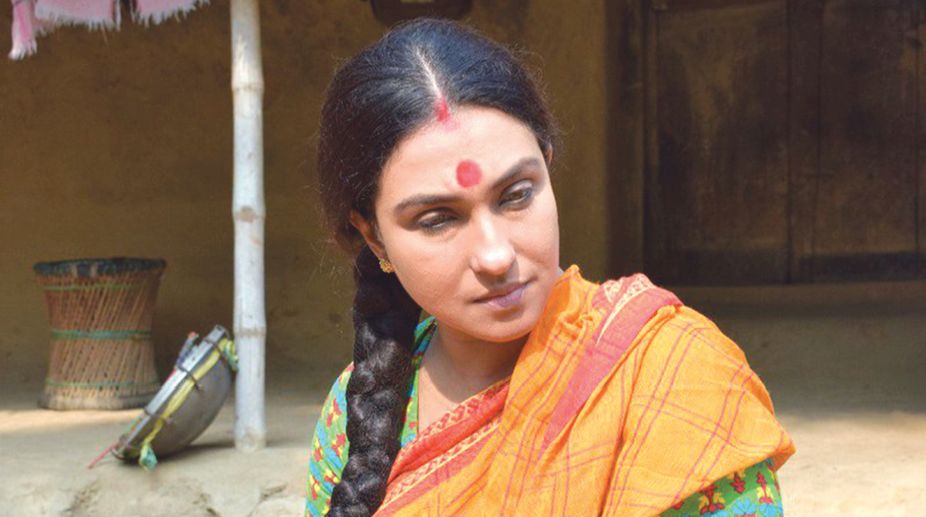Meghna Gulzar shares family moment with Rakhee and Gulzar: samose, chai aur baarish
Meghna Gulzar shares a cozy monsoon snapshot of Rakhee and Gulzar enjoying samosas and tea, sparking nostalgic joy.

Rituparna Sengupta in a still from Rong Beronger Kori.
There was a time when Indian cinema was divided between popular concoctions and dreams, on the one hand, sold with varying degrees of success and art house ventures, on the other, that seldom reached the theatres. If they did, the films could never expect a decent run and had to be satisfied with awards or festival slots or both.
Between the two forms, there emerged what came to be known as the middle cinema that claimed to be rooted in more emotional experiences and restrained treatment with performances that threw up a new generation of talented actors.
When it came to directors like Gulzar, Hrishikesh Mukherjee and Basu Bhattacharya, there were instances of stars being asked to shed the excesses on which they thrived in blockbusters.
Advertisement
The middle cinema has now gone into the pages of history. Mainstream ventures like Dangal, Bajrangi Bhaijan, My Name is Khan, Padman, Piku and now Hichki have sought to move out of the realm of fantasy to blend reality with elements of popular appeal.
A heightened awareness of the possibilities of the medium along with expansion of markets as a result of digital technology has allowed filmmakers to move into a larger canvas of social experience and experiment.
The explosion of ideas that is now evident — considered beyond the purview of popular cinema till a few decades ago — has thrown up an exciting choice of new directors on the national scene.
This has influenced some regions as well and the Marathi and Malayalam cinemas, for instance, have been demonstrating interesting departures from the ordinary both in terms of subjects and cinematic treatment.
One would have expected Bengal to go the same way on the strength of inspiration derived since the 1950s — not just Ray, Ghatak and Sen but also their contemporaries like Tapan Sinha, Asit Sen, Ajoy Kar and Bijoy Bose and the generation that followed.
Sparks of brilliance were witnessed in the early films of Rituparno Ghosh who was seen as the most powerful symbol of change along with Anjan Dutt and later Kaushik Ganguly, Atanu Ghosh and Arindam Sil.
But eventually they comprised just a handful in a scenario that has seen an explosion on the production front. Some of the regulars have run into a pathetic cycle of mediocrity, some have been attempting to do too much with diminishing returns and the stream of newcomers has been anything but inspiring.
Sahaj Paather Gappo and Asha Jaowar Majhe were perhaps the only examples of first-timers making a presence though it is anyone’s guess whether Aditya Bikram Sengupta and Manas Mukul Pal will be moving on to their next projects with an eye on theatre audiences rather than on festivals that have fetched them handsome rewards.
Not that attempts have not been made by many, who have mainstream audiences in mind, to move out of the conventional sphere. The question is whether they can actually rise to the challenge.
The task of wrapping social statements in cinematic styles that are seen to be convincing, demands a kind of self-assurance that cannot be achieved with unconvincing experiments. It is curious why the new class of filmmakers that is trying to make its presence felt has failed to explore contemporary social concerns in the way their counterparts have done in the Marathi cinema with support from the government.
At the same time, it needs to be said that support can only make sense when the projects match the expectations of discerning audiences. In Bengal, the problem appears to lie in the root — an uninspiring choice of subjects made worse by screenplays written by unprepared newcomers. This is the kind of weakness that obstructs an effort like Rong Beronger Kori.
Simple treatment of screenplays adapted from four short stories based on the cruel influence of money has possibilities — however limited they might be. Instead the small plots barely manage to rise above mundane encounters with contemporary life.
The best example of a single idea running through short stories — seen in their totality — is Teen Kanya. While the variations in tone were as gripping as the scripts adapted from Tagore stories, the overall results mattered more than the parts. It is unfair to compare a master with young aspirants.
The question remains as to why the attempt to be consciously different and ambitious had to be made when the offbeat structure cannot be justified by the overall impression.
However, the film does reveal flashes of competence especially from some of the actors. Kharaj Mukherjee stands out even in small parts and, in this case, he is helped by the twist in the tale of a rustic couple seeking divorce. The other parts are also partly redeemed by good performances.
Rituparna Sengupta and Ritwik Chakraborty play characters reflecting the darker side of Kolkata while Arunima Ghosh is the young wife with an eye on the wealth of a much older husband and her heart extended to a younger man.
The most effective character is a teenager in the village who moves desperately to the city to save his sick mother. The acting rises above the average but cannot rescue the ordinariness of the scripts as a whole.
However, the treatment reveals signs of restraint and tenderness as well as a desire to acquire a personal style that can well be developed into more meaningful work.
Advertisement